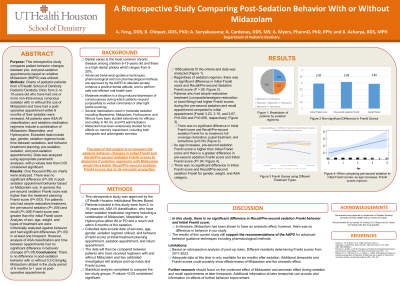Sedation
138 - A Retrospective Study Comparing Post-Sedation Behavior With or Without Midazolam


Anna Feng, DDS
Pediatric Dental Resident
University of Texas Health Science Center-Houston
University of Texas Health Science Center- Houston
Lakewood Village, Texas, United States- AC
Antonio Cardenas, DDS, MS
University of Texas Health Sciences- Houston
- BC
Brett Chiquet, DDS, PhD
University of Texas Health Science- Houston
- AM
Alan Myers, PharmD, PhD, RPh
University Texas Health Science Center- Houston
- AS
Angela Suryakusuma, Dental Student
University of Texas Health Sciences- Houston
- BA
Bhavini Acharya, BDS, MPH
University of Texas Health Sciences- Houston
- BA
Bhavini Acharya, BDS, MPH
Associate Professor; Program Director, Pediatric Dentistry Residency
University of Texas Health Science Center-Houston
Houston, Texas, United States
Presenting Author(s)
Co-Author(s)
Program Director(s)
Purpose: This retrospective study compares patient behavior changes between pre- and post-sedation appointments based on whether Midazolam (IM/PO) was utilized.
Methods: Charts of pediatric patients from UTHealth School of Dentistry Pediatric Dentistry Clinic ages 2- to 10-years-old who have had one or more non-intravenous conscious sedations with or without the use of Midazolam who had a post-operative appointment within 6 months of their sedation were reviewed. All patients were ASA I/II classification, and sedation regimens included various combinations of Midazolam, Meperidine, and Hydroxyzine. Extracted data included age, gender, sedation regimen/route, time between sedations, and behavior (treatment planning, pre-sedation, sedation, and post-sedation appointments). Data was analyzed using appropriate parametric analyses, with p-values less than 0.05 considered significant.
Results: One thousand fifty-six charts were analyzed. There was no significant difference (P >.05) in post-sedation appointment behavior based on Midazolam use. In general, the pre-second sedation Frankl score was higher than the treatment planning Frankl score (P=.003). For patients who had simple restorative treatment, the pre-second sedation (P < .004) and recall (P < .006) Frankl score was greater than the initial Frankl score. Analysis of sex, age, weight, and types of treatment were individually analyzed against behavior and had significant differences (P < .05) in at least one timepoint. However, analysis of ASA classification and time between appointments had no significant difference in behavior changes (P >.05).
Conclusion: There is no difference in post-sedation behavior with or without 0.2-0.5mg/kg Midazolam utilized in the study period of 6 months to 1 year at post-operative appointments.
Identify Supporting Agency and Grant Number:

.jpg)